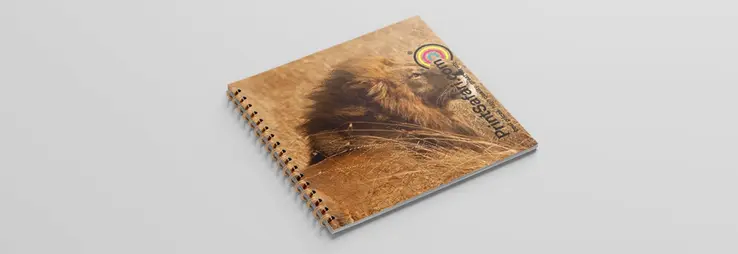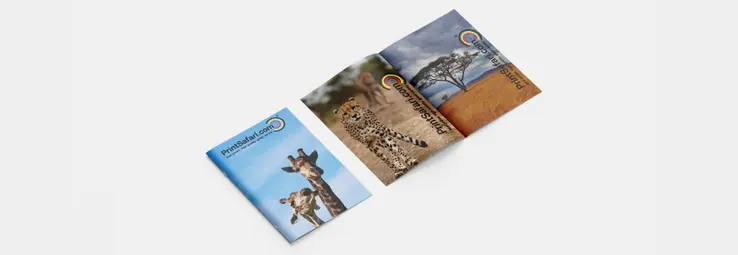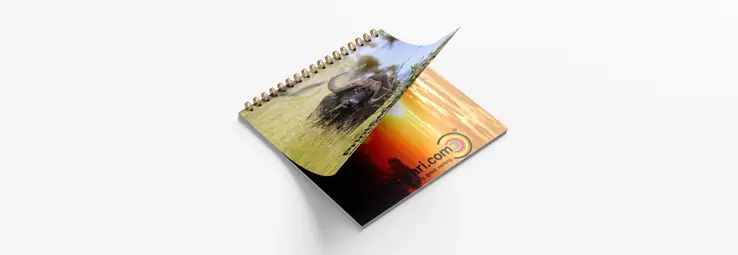How to Layout a Booklet for Printing?
Booklet printing involves several crucial steps to ensure that the final product looks professional and is easy to read. Whether you’re designing a brochure, catalog, or informational booklet, arranging and formatting your pages is crucial. You must arrange booklet pages in the correct order and format before printing. This can be tricky, especially with a large booklet with multiple pages.
In this guide, we’ll walk you through the process of laying out a booklet for printing, covering everything from page count and arrangement to PDF preparation and binding methods.

Steps to Layout a Booklet for Printing
Here is how you can layout your booklet for printing:
Step 1: Determine the Booklet Page Count
Before designing your booklet, you need to decide on the page count. The page count is important as it dictates the size of the booklet, the amount of content you can include, and the binding you will use. Typical booklet page counts are in multiples of four because each printed sheet can accommodate four pages (two on each side). Common page counts include 4, 8, 12, 16, etc.
If your page count is not divisible by four, add some blank pages at the end of your booklet to make up the difference. For example, if you have a 15-page booklet, add one blank page at the end to make it 16 pages.

Step 2: Arrange Pages for Booklet Printing
The next step is to arrange pages for booklet in the right order for printing. This differs from the order you see on your screen or in your PDF document. When you print a booklet, the multi-page document will print side by side on separate sheets of paper and then be folded and stapled together. This means that your booklet’s first and last pages will be printed on the same sheet, the second and second-to-last pages on another sheet, and so on.
In a saddle-stitched booklet (a common binding method for small booklets), pages should be arranged as follows:
- The first and last pages should be the booklet cover (front and back).
- The second-to-last page is typically reserved for copyright information or disclaimers.
- The center of most pages will be the center spread of your booklet.
- Arrange pages in consecutive order, with the inside pages placed in pairs (e.g., page 2 next to page 15, page 4 next to page 13, and so on).
To arrange the pages for booklet printing, you can use a software program with a booklet printing feature, such as Adobe Acrobat or InDesign. Alternatively, you can manually rearrange the pages using a PDF editor or an online tool. You can also create a simple mock-up of your booklet using paper and scissors to help you visualize how the booklet’s pages will be printed and folded.

Step 3: Final Page Layout
Once you have arranged the pages for booklet printing, check the final layout of your booklet. This includes checking the page numbers, margins, alignment, bleed, and crop marks.
Here are some tips to ensure that your final page layout is ready for printing:
- Include page numbers, typically at the bottom or top corners. Ensure page numbers follow the correct order, especially when you have two or four-page spreads. Page numbers should be clear and easy to read. The page numbers should be on the outer edge of each page, not on the binding edge or in the center.
- Ensure your margins are consistent and large enough to avoid cutting off important content. Increase the margin on the binding edge to account for the fold line and the staples.
- Your alignment must be consistent and accurate. Adjust the alignment of some elements, such as images or text boxes, to avoid them being split across two pages or falling into the fold line.
- Set bleed and crop marks correctly. If your booklet includes images or graphics that extend to the edge of the page, make sure to include bleed. Bleed is the extra area around your page that extends beyond the trim line. Crop marks are the lines that indicate where your page will be cut. Set different bleed values for different edges of your page, depending on how they will be trimmed.
- Check whether your separate file format is suitable for printing. The best file format for printing booklets is PDF because it preserves the quality and layout of your document. You should also ensure that your PDF file is in the correct color mode (CMYK) and resolution (300 dpi) for printing. .

Step 4: Create a Print-Ready PDF
Before sending your booklet for printing, export your layout as a print-ready PDF document. Check the following settings:
- Use the correct page size and bleed settings.
- Embed fonts to ensure consistent text appearance.
- Set the color mode to CMYK for accurate printing.
- Enable printer marks and bleeds if necessary.
- Ensure all images are high-resolution (usually 300 DPI).
Step 5: Submit the Files to the Printer
Once satisfied with the final page layout, print settings, and file preparation, submit your print-ready PDF file to the printing company. Be sure to communicate specific instructions or requirements, such as paper type or binding preferences. You should provide the printing service with your PDF separate file and specify the paper size, type, binding type, and quantity you want. Besides, ask for proof or a sample of your booklet before printing the final version.
Booklet Layout Considerations for Binding Types
Different binding methods have specific layout requirements:
1. Saddle-Stitched Booklet
For a saddle-stitched booklet, arrange your pages in multiples of four. Remember that pages in a saddle-stitched booklet are printed on large sheets and folded in half, so adjacent pages should be designed to appear side by side when opened. The saddle-stitched booklet is one of the most preferred choices for printing booklets.

2. Spiral Binding
Spiral binding requires holes punched along the binding edge. Ensure that no critical content is placed too close to the binding edge to avoid distortion when pages are bound.

3. Wire Staples
When using wire staples, remember the centermost pages, as they may not open flat. Consider placing less critical content on these pages.

Printer Spreads
Printer spreads (also known as imposition spreads) refer to how pages are arranged for the actual printing process. They are designed to optimize the use of large printed sheets that are then folded, trimmed, and bound to create the final booklet. Here’s how printer spreads work:
Sequential Order: Pages in printer spreads are organized in a sequential order (two-page spreads) based on how they will be physically printed on large sheets of paper. For example, if you have a 16-page booklet, the pages will be arranged in the following way for printer spreads: 16-1, 2-15, 14-3, 4-13, and so on.
Designed for Printing Efficiency: Printer spreads are created to minimize paper waste and ensure the pages align correctly when folded and bound. Printing companies prefer receiving files in printer spreads because they simplify the process of printing booklets.
Reader Spreads
Reader spreads, on the other hand, represent how the pages will be viewed and read by the audience. They show the booklet’s content in the order it will appear when opened and read. Here’s how reader spreads work:
Sequential Reading Order: Reader spreads are organized in a sequential reading order. For example, in a 16-page booklet, the reader spreads would be 1-2, 3-4, 5-6, and so on.
Designed for Clarity: Reader spreads ensure that the content flows logically, making it easy for readers to follow the narrative or information presented in the booklet. When proofreading or reviewing content, using reader spreads to ensure it is coherent is often helpful.
Final Thoughts
In conclusion, laying out a booklet for printing involves careful planning, attention to detail, and adherence to specific printing requirements. By following these steps, you can ensure that your booklet looks professional, reads smoothly, and serves its intended purpose effectively. Whether you’re creating a small brochure or a substantial catalog, the correct page order, print settings, and binding method will contribute to the overall quality of the finished product. With the right approach, you can produce a durable and visually appealing booklet that leaves a lasting impression on your audience.
Hassle-Free Booklet Printing Made Easy
Looking for a reliable and affordable way to print professional booklets? We’ve got you covered! Our high-quality booklet printing service offers a range of options tailored to your needs. Whether it’s for marketing, education, events, or any other purpose, we’ll help you create stunning booklets that leave a lasting impression.
Customizable Options
Choose from various sizes, paper types, binding styles, and finishes to perfectly match your vision.
Flexible Design
Upload your own design or use one of our templates to create your booklets online with ease.
Fast and Affordable
Enjoy quick turnaround times, competitive pricing, and exceptional customer service.
Order your booklets today and showcase your ideas with professional quality that stands out!
get an instant print quote!







